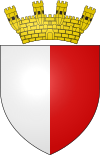Mdina
| coat of arms | map |
|---|---|

|
|
| Basic data | |
| State : | Malta |
| Gzejjer : | Malta Majjistral (Northwest Malta) |
| Distretti : | Western film |
| Area : | 0.885,165 km² |
| Residents : | 243 (December 31, 2018) |
| Population density : | 275 inhabitants / km² |
| ISO 3166-2 : | MT-29 |
| Postal code : | MDN |
| Website : | http://www.mdinacouncil.com/ |
| politics | |
| Mayor : | Peter Dei Conti Sant Manduca ( PN ) |
Coordinates: 35 ° 53 ' N , 14 ° 24' E
Mdina is one of the former capital cities of Malta with a population of 243 today (as of December 31, 2018).
geography
Mdina is located in the western center of the island of Malta on a 185 meter high foothill of the Dingli plateau, the north, east and north-west slopes of which rise steeply from the landscape. Immediately to the south-west is the larger twin city of Rabat .
history
The origins of the settlement of Mdina go back to the Bronze Age , when the hill served as a place to live because of its strategic location. The Phoenicians expanded it as a fortress and called the place Malet = place of refuge. In Roman times the name changed to Melita . The Romans surrounded the city together with the neighboring Rabat with a strong fortress wall. At that time the city was inhabited by almost 1,000 people. After the Arabs conquered the Maltese archipelago in 870 , they gave the city the current name Mdina = city . In order to be able to defend them better, they reduced the fortification belt to the urban area of Mdina. The city wall was strengthened again during the time of Norman rule in the 12th century. So conveniently located and fortified, Mdina withstood an attack by 18,000 Hafsiden in 1422 and received the honorary title “Città Notabile”.
The Hospitallers , who settled in Malta in 1530, initially agreed with the city's strategic location, so they chose Mdina as their first residence. As it soon became apparent that Malta could be controlled more cheaply from the coast, Mdina had to cede capital status to Birgu . Now the city was only of importance for the Maltese nobility, who continued to hold the seat of their self-government, the Università, here. After Valletta was named the final capital of Malta in 1571, the island's population moved to the new metropolis, which led to a significant population decline in Mdina. Nevertheless, Lorenzo Gafà , church builder in Malta, was commissioned in 1697 to rebuild St. Paul's Cathedral , which was destroyed in the 1693 earthquake . It was consecrated in 1702 and is considered a masterpiece of the builder.
The city from the end of the 20th century
Mdina has become a tourist center where time seems to have stopped. The medieval townscape is characterized by narrow streets and the palaces and churches built from the sand-colored limestone that is typical of Malta. Mdina is also called the quiet city because there is only one hotel and few restaurants, so most of the tourists are day visitors. In the evening, the place is almost deserted.
Buildings (selection)
- The main entrance to the city is the Main Gate, which the Grand Master of the Order of Malta Antonio Manoel de Vilhena (1663-1736) had built.
- On the eastern edge of the city rises the Cathedral of St. Paul , behind whose simple double-towered facade a splendidly designed three-aisled interior is visible. While the floor is covered with colored marble tombstones, Sicilian paintings with scenes from the lives of the apostles Peter and Paul adorn the vaulted ceiling.
- South of the cathedral is the Cathedral Museum , whose greatest treasure is a collection of engravings and woodcuts by Albrecht Dürer forms.
- In the north of the city is the Palazzo Falson , also known as the Norman House because of its facade decorations from the Norman era .
traffic
Mdina was from 1883 to 1931 by the railway Valletta Mdina with Valletta connected.
In the media
The city gate of Mdina is used in the first season of the American fantasy television series Game of Thrones as the city gate to the capital King's Landing.
Sons and daughters
- Francesco Az (z) opardi (1748–1809), composer
- Joseph Calleia (1897–1975), actor
literature
- Stanley Fiorini, Mario Buhagiar: Mdina, the Cathedral City of Malta: A Reassessment of Its History and a Critical Appreciation of Its Architecture and Works of Art. Central Bank of Malta, 775 S., ISBN 99909-975-1-9 (Engl .)
Web links
Individual evidence
- ↑ StatDB of the National Statistics Office Malta , accessed on August 1, 2020
- ↑ Cathedrale & Museum , accessed November 22, 2016.
- ↑ The stunning real-life locations where Game Of Thrones is filmed. In: Daily Mail. April 30, 2014, accessed July 7, 2016 .





